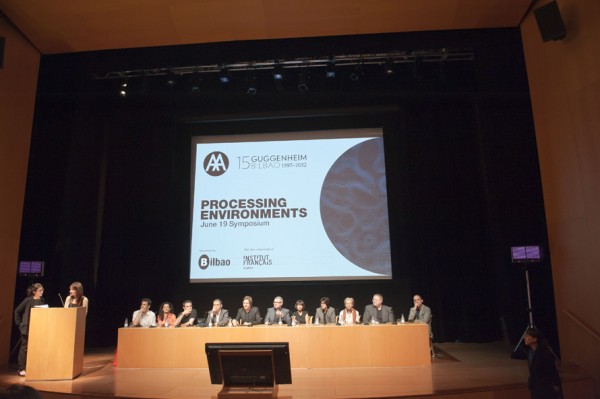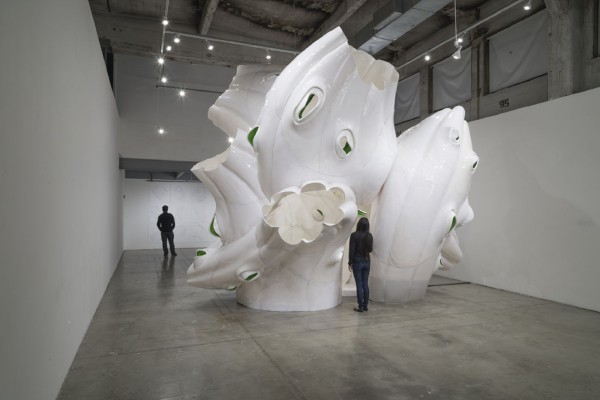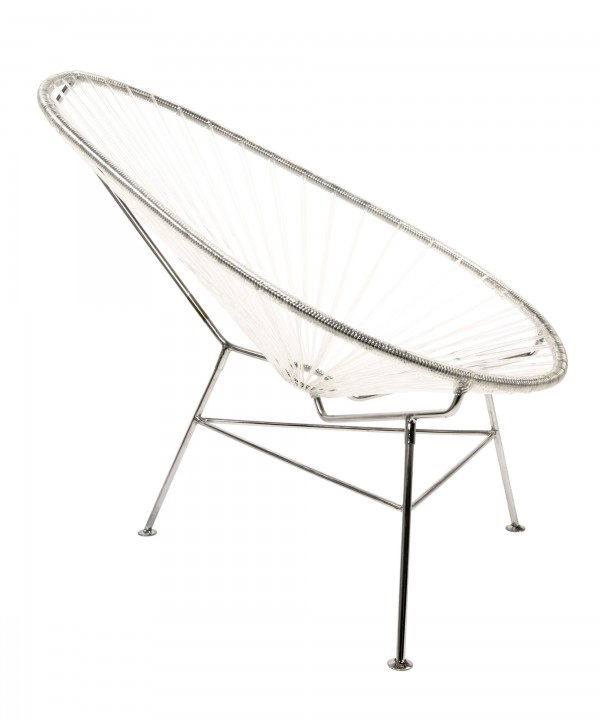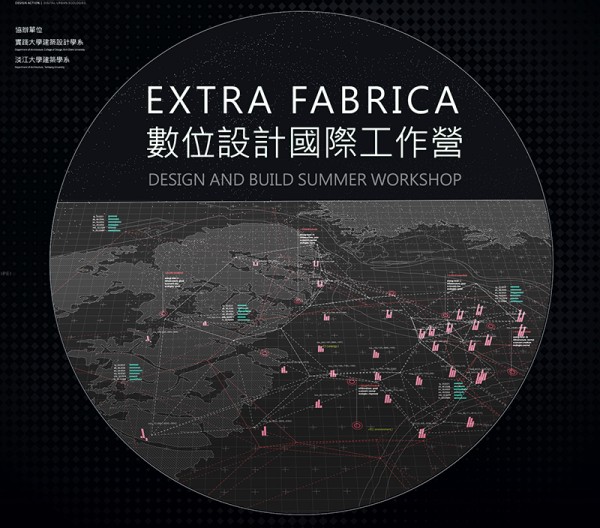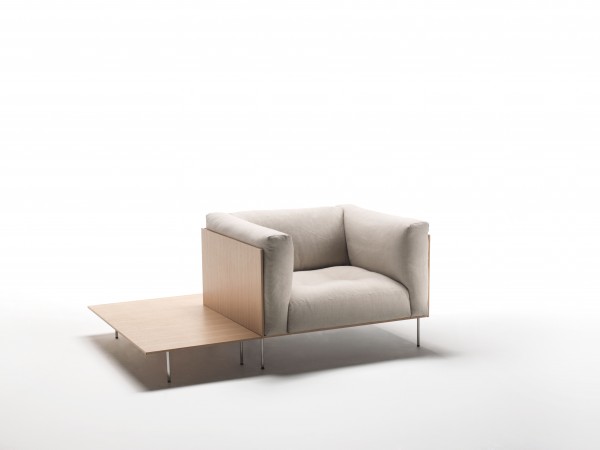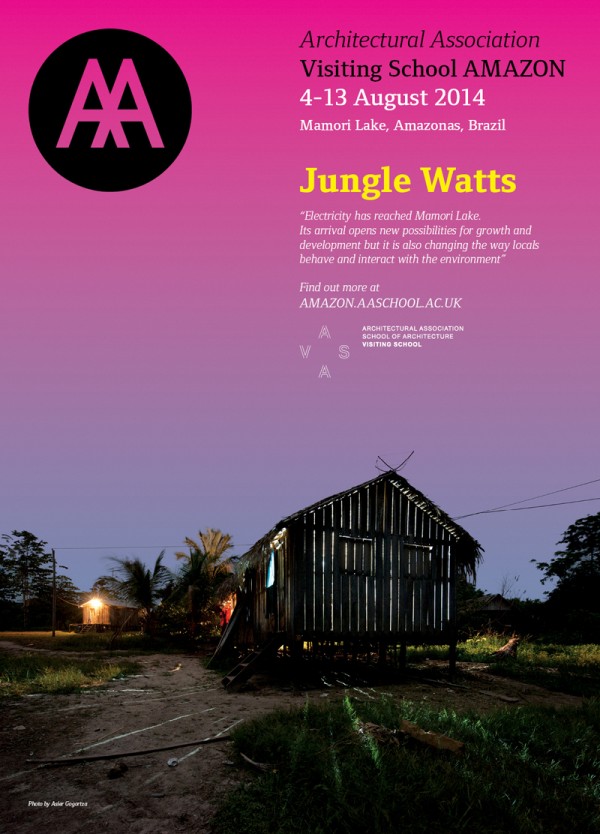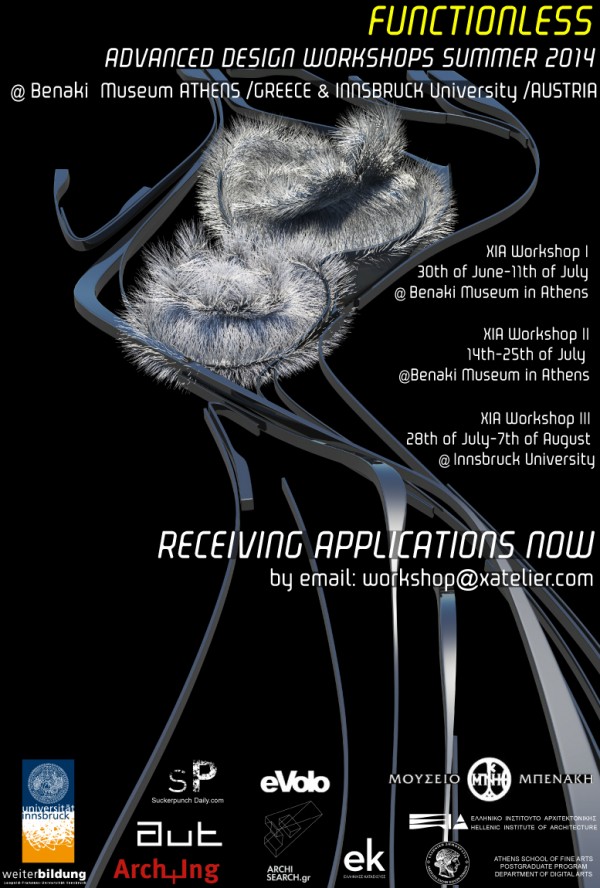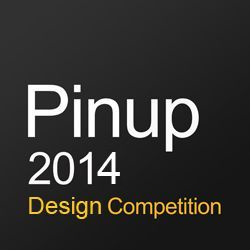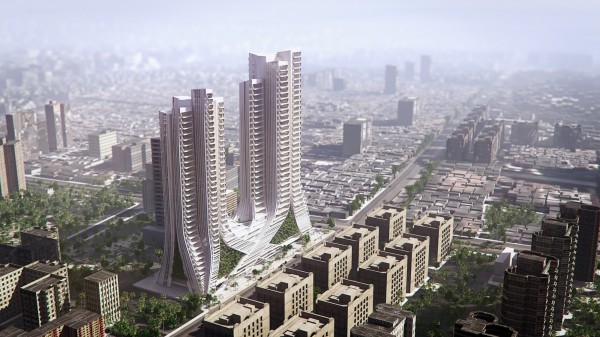20 Scholarships for AA BILBAO Visiting School: COMPUTING TOPOS III 2014
The AA Visiting School is a worldwide network of design workshops and other programmes organised by the Architectural Association School of Architecture. The event will take place in Bilbao from July 23rd to August 5th, focusing on new lectures over territorial macro and micro scales.
We have 20 scholarships for our readers interested on this activity, you just need to send us your CV/portfolio and a statement explaining why you would like to participate in this event. For more details read below.
The workshop will explore the question of ‘place’ or ‘topos’ and its radical transformation in the recent years due to the proliferation and availability of environmental parameters. Departing from the notion of ‘computing,’ understood as information processing, strategies of ‘data mining’ and ‘indexing’ will be proposed as sensible readings of the site and the territory.
The breeding of local environmental parameters will generate new forms of architectural agency and expression. Diverse mechanisms will be used to materialize ‘invisible’ information such as environmental and social conditions, users’ preferences, digital information, etc. The capture of ‘local’ data will be done through the use of sensors, site specific simulations and rss feeds which will be used to capture information in the ‘network’. The workshop will provide the students with technical support to use microprocessors and sensing technologies. Each team will be looking at one main environmental parameter, in its broader sense, such as sun light, programmatic densification, urban flux, users’ data collected from urban behavioural patterns, potential energetic consumption/production, etc to synthesize ‘Datascapes’ that will feed into the projects. These ‘Datascapes’ will be built from the following devices, software and strategies. Read the rest of this entry »
Apertures By Baumgartner + Uriu Challenges The Notion Of An Architectural Opening As A Static Object
Within the discipline of Architecture, the discussion of fields, networks, and smooth transitions has dominated the dialogue over the past 15 years. Rooted in philosophical models by Deleuze, systems theory, and parametricism, it has influenced many generations of architects. Parametricism promotes a relational ontology in which entities have no autonomous reality and are based on “continuous differentiation;” everything is connected, everything flows.
This position of an architecture rooted in dynamism and deterritoriali-zation is being opposed by a radically different approach, giving way to a contemporary design practice working with discrete figures that cannot be entirely understood through its pristine digital relations. This position is one that is obsessed with capturing qualities that would appear to be incongruous by incorporating analog features into a digital design process. The installation Apertures, designed for the SCI-Arc Gallery, is firmly positioned within this approach.
Apertures are the architectural catalysts for the installation design, being defined as objects within a larger building object that differ from its host in terms of morphology and performance. They are disruptive features to the overall building mass, but are able to interact with their environment, focusing on a symbiotic relationship between nature, building morphologies, and material expression.
Apertures have been an ongoing topic in our work, challenging the notion of an architectural opening as a static object by re-defining the DNA of a window, both in terms of its appearance and materiality, as well as its nature as an object in continuous flux, responding to its environment through movement or sound.
The 16-foot-tall, thin shell structure was designed to solely rely on its extremely thin surface (1/8”) as support, requiring no additional structural elements. Structure and surface are collapsed into a single component supported through its shape, creased surfaces and material strength only. Each one of the 172 panels is unique in terms of its shape. They are CNC milled from polyurethane foam, heat formed out of thermoplastic polymer resin, and then laminated together into a single object.
Unique to this project is the proposal of building as organism, challenging how architecture can interface with its users and its environment in a much more intuitive way. This entails both the use of technology to augment its performance and a design aesthetic that is incongruous and can incorporate analog features into a digital design process.
The project also offers a radically new design approach to sustainable design, emphasizing an Architecture in-between nature and technology that can operate as an interactive building organism where multiple discrete features operate simultaneously and independently. In this case sound is used to bridge the gap between the natural and the artificial, allowing the visitor to experience their own biorhythms.
Baumgartner+Uriu (B+U) Herwig Baumgartner and Scott Uriu, the founders of Baumgartner+Uriu (B+U), are an internationally recognized design duo operating at the forefront of contemporary design. Their design process can be described as driven by digital techniques and advanced computation that utilizes new technologies and material resources. B+U’s work consistently pushes the boundaries of architecture and urban design, experimenting with new spatial concepts, and intensifying existing urban landscapes in pursuit of a visionary aesthetic that encompasses all fields of design.
B+U recently exhibited at the FRAC Center in Orleans, France; the Centre Pompidou in Paris, France; the Museum of Contemporary Art (MOCA) in Los Angeles, California; and the 12th Architecture Biennale in Venice, Italy.
Two monographs have been published on Baumgartner and Uriu’s work. It has also been widely published and discussed in books, magazines and newspapers. The firm was recently awarded with the Maxine Frankel Award for design research, the AIA national award for emerging professionals and the Architizer A+Award for sustainability and the Graham Grant for advanced studies in Fine Arts. Read the rest of this entry »
Acapulco Chair 60th Anniversary Limited Edition
The Acapulco Chair is one of the most iconic chairs of the 20th Century. This year The Common project is celebrating the chair’s 60th Anniversary with a very special Limited Edition. The 60th Anniversary Edition consists of a chrome-plated frame with a translucent shell. The choice of materials evokes refinement and sophistication and brings the classic design into the 21st Century. It has been transformed from a fun patio chair into luxury indoor and outdoor seating. Only 600 chairs were produced.
The Common Project produces the authentic classic born in 1953 in Acapulco, Mexico and highlights its rich history in the world of design. The chair is also available in the 4 classic colors: black, white, mustard, and turquoise.
The 60th Anniversary Acapulco Chair is available for a limited time at The Common Project. Read the rest of this entry »
Extra Fabrica 2014: Summer Design Build Workshop In Taipei
DEZACT is pleased to announce Extra Fabrica 2014, a design & build studio-based workshop in Taipei, Taiwan from 28th June 2014 to 09th July 2014.
ExtraFabrica2014, a workshop on digital design and fabrication procedures, is being conducted in June-July 2014 in association with Shih Chien University and Tamkang University in Taipei, Taiwan. The interdisciplinary workshop provides an opportunity to architects and designers to be a part of the 12 day studio and investigate interactive design and fabrication solutions for dynamic socio-cultural fabrics.
The studio will investigate digital design and fabrication procedures in relation to the condition and context of Asian cities , Taipei in particular. The aim of the design studio will be to introduce computational design through using generative, algorithmic, data simulation and parametric design based techniques. Design proposals to develop new systems of mass customised building systems will be investigated through both physical and computational methods. Participants will use multiple software platforms for modelling, simulation and fabrication, towards multiple, variable and recursive prototypes for a range of urban conditions, driven by scenarios of future incremental, adaptive growth and change. Scaled prototypes will be fabricated in the studio and selected designs will be constructed at 1:1 scale based on the building systems developed. Participants will get the opportunity to explore advanced fabrication techniques and gain the knowledge of the workflow from design to production. Read the rest of this entry »
1:1 Piero Lissoni Exhibition In Chicago At Luminaire Showroom
Celebrating 40 years of enduring partnerships and commitment to bringing the best in contemporary design to the public, Luminaire is honored to host the internationally renowned architect and designer Piero Lissoni.
The co-founder of Lissoni Associati, as well as the creative director of Living Divani, Glas Italia and Porro, Mr. Lissoni has brought forth a mastery of proportion and insightful sensibility to all his designs.
Lissoni has established himself as one of most notable names is contemporary design for his clean, industrial aesthetics while collaborating with many of the world’s most notable design companies. His approach begins from a humanistic vision which, for him, is the only one that would make sense to a true designer no matter the medium. Lissoni approaches his work with a mastery of proportion and an acute sensitivity for the subtlety that distinguishes the common from the insightful; clear lines, subtle forms and an eye for special materials surround his designs with sophisticated simplicity.
Piero Lissoni, as main interpreter of Porro design, year after year studies new eye-catching compositions of the company’s three systems – Modern day system of containers and suspended tops, Storage system of wardrobes, open wardrobes and walk-in closets and System day system of bookcases and equipped walls – and revamps the codes of esthetics for the living area and sleeping area enriching the brand’s collection with new products. Among them, some of the company’s iconic pieces, such as the Reflection Mirror, Tiller and the brand-new table Ipe, are exhibited inside Luminaire showroom.
Porro stands out for its essential and immediately identifiable language, with minimal geometries and shapes, without forgetting its unique company philosophy: simplicity above all. All Porro products are the result of a subtraction and derive from a progressive simplification process. Even the systems, which are complex in themselves, are the result of a very simple aesthetic vision, based on consistency and simplification without forgetting the highest quality.
Inspired by the pure geometry of the square, Piero Lissoni’s Modern is a diverse and versatile storage system based on the movement of the square through space. By utilizing a module that repeats itself to generate objects different in materials, colors and functional purposes, Modern becomes an adaptable and modular system. These functional aspects are combined with Lissoni’s mastery of proportion and detail, ensuring that the resulting designs – no matter the combination of elements – remains consistent and harmonious in form. From wall units to free standing storage, Modern is appropriate for every habitat.
In the designing process of mirrors, furniture, accessories, shelves, bookcases, tables and low tables, Glas Italia avails itself of the collaboration of renowned designers who – experimenting in full freedom on the technologically advanced productive plants made available by the Company – can express their creative talent, pointing out the inexhaustible potentialities of such a pure, noble and refined material as glass. Lissoni designed truly magnificent mirrors with Murano glass frame, achieved through a complex and refined hand-made production process, making each piece unique and unrepeatable.
With an attentive eye to materials, form and proportion, Piero Lissoni’s designs represent a form of modernism. His Verglas Table for Glas Italia, constructed from boxed transparent tempered glass, builds upon his trademark aesthetics. Thanks to a complex gluing and manufacturing process, the table has a visual lightness which dissolves the boundary between sculpture and furniture. The result is a table of great strength and formal purity and at the same time characterized by the great volumetric presence.
Piero Lissoni approaches his work for Living Divani with modularity and subtlety. His mastery of proportion distinguishes the common from the insightful; clear lines, subtle forms and an eye for special materials surround his designs with sophisticated simplicity. The Extrawall sofa has a distinctive, regimented style featuring a square design and prominent corners. The seats, backs and arms of sofa are innovatively dimensioned and form the elements that can be freely mixed and matched to shape and outline the product. The island-like design of the Extrawall astonishes for the many combination and covering possibilities that make it hugely adaptable and versatile, able to show its endless faces with elegance and refinement.
Piero Lissoni and Luminaire have joined forces on a new collaboration, initially started many years ago. The exhibition “1:1 PIERO LISSONI” will introduce Lissoni architectural and design language to United States, bringing a section of the Milanese studio to Chicago. Read the rest of this entry »
Jungle Watts: Architectural Association Visiting School Amazon, Summer 2014
Jungle Watts
4-13 August 2014
Mamori Lake, Amazon, Brazil.
The Architectural Association Visiting School Amazon is organizing a 10-day workshop in the Brazilian Amazon rainforest that will analise the impact of the recent arrival of electricity to the Mamori Lake community, 65 km. south of Manaus. Participants will speculate about future scenarios for the sustainable development of the area as well as propose architectural interventions that explore creatively the opportunities and risks of having electricity in the middle of the jungle.
The registration is now open and there are only 12 places available. The deadline for applications is 4 July 2014. The workshop is open to current architecture, engineering and design students, PhD candidates and young professionals and will take place in a simple but comfortable wooden lodge by the Mamori lake shore, in the middle of the Amazon rainforest.
The initial exploratory days of analysis and data collection will offer the participants the possibility to discover the Amazon ecosystem and interact with the local communities. Different layers of the Mamori lake reality will be analyzed and measured. The social, the mythological, the economical, the natural and the climatological will be overlaid with the electricity network to discover emerging patterns that could inform the design process. Through the use of quantifiable data collection, parametric modeling, computational analysis and simulation, students will propose architectural strategies that can shed some light on this critical conjuncture. The strategies of some plants, insects and animals will be studied to trace parallels between nature and architecture.
AA Visiting School Amazon is kindly sponsored by Luminaid.com and Bareconductive.com.
More information can be found on:
http://amazon.aaschool.ac.uk
http://www.aaschool.ac.uk/STUDY/VISITING/amazon
http://www.facebook.com/aavsamazon
http://www.vimeo.com/aavsamazon
http://aavsamazon.tumblr.com Read the rest of this entry »
Functionless: Advanced Design Workshops Summer 2014
ATHENS – INNSBRUCK SUMMER 2014
X|A Summer Workshops : RECEIVING APPLICATIONS NOW : workshop@xatelier.com
For more information http://www.xatelier.com/workshop
Participation cost is 550 euros for each workshop
X|A ATHENS Workshop I: 30th of June -11th of July 2014 @ Benaki Museum in Athens, Greece
X|A ATHENS Workshop II: 14th of July – 25th of July 2014 @ Benaki Museum in Athens, Greece
X|A INNSBRUCK Workshop III: 28th of July – 7th of August 2014 @ University of Innsbruck, Austria
X|Atelier is organizing three international intensive workshops of Advanced Architectural Design. The X|A Summer Workshops 2014 are led by X|A principals Erick Carcamo (SCI-ARC, UPenn) and Nefeli Chatzimina (USC, NTUA), both Allumni Graduates of Columbia University in New York City.
X|A Athens Workshops I&II are organized under the auspices of the Hellenic Institute of Architecture and the Athens School of Fine Arts. Selected Participants will attend the computation design workshops, academic lectures, final reviews and exhibition at Benaki Museum of Athens from 30th of June -11th of July 2014 or from the 14th -25th of July 2014. Daily meetings will take place from 10am to 6pm at the Benaki Museum of Pireos 138 in Athens.
X|A Innsbruck Workshop III is hosted by the University of Innsbruck. Selected Participants will attend the computation design workshops, academic lectures, final reviews and exhibition at the University of Innsbruck from the 28th of July – 7th of August. Daily meetings will take place from 10am to 6pm at the University of Innsbruck.
As part of an ongoing academic research, X|A workshops introduce participants into contemporary discussions of formal exploration in Architecture and Art. Through technical attainment of design and digital production the X|A Workshops give the opportunity to students of Architecture and Art, Professional Architects, Designers and Artists to challenge new design territories. Our goal is to explore innovative, potential architectural expressions of the current discourse around Form through computational tools (Autodesk MAYA). We will focus on technique elaboration, material intelligence, formal logic efficiencies and precision assemblies as an ultimate condition of design. The workshop will develop and investigate the notion of proficient geometric variations at a level of complexity, so that questions towards geometrical effectiveness, accuracy and performance can begin to be understood in a contemporary setting. The workshop is a discourse based in the use of multi-layered techniques and production processes that allow for control over intelligent geometries, calibration of parts, and behavioral taxonomies, normalizing an innovative held of predictability.
X|Atelier was founded in 2007 by Erick Cárcamo and Nefeli Chatzimina ::X|A:: is an architectural practice based in the use of multi-layered experimental techniques and production processes networked in Europe, US and Latin America. Both hold a Master’s of Science in Advanced Architectural Design from Columbia University and have graduated from SCI_Arc and N.T.U.Athens respectively. Their teaching expertise extends to Sci-Arc, University of Southern California, Columbia University, Yale SOA, UPenn, Pratt Institute, University of Kentucky, Die Angewandte, N.T.U.Athens and LTH in Sweden. X|A’s work has been internationally published and exhibited at galleries in New York, Los Angeles, London, Lexington and Barcelona. Their working experience is held in offices of Bernard Tschumi Architects in New York, CoopHimmelb(l)au in Vienna, Asymptote NYC and Xefirotarch LA.
More information here.
Pinup 2014 Competition
Pinup 2014 invites students and young professionals to submit a collection of their studio, 3d printed or un-built work comprised of up to three digital images. By submitting your work, we invite you to share your voice with the collective intelligence of a community of visual thinkers. The competition is free to all entrants.
The proliferation of device culture, social networking, and cloud technology are changing the way we create, and connect on a daily basis. For design, this means that technology is not only transforming the process of production, but also the processes through which we share, critique, and organize ourselves around the work we do. The competition is first, and foremost an experiment in distributed intelligence. By leveraging the “wisdom of crowds” every entrant can see and understand how his or her work is experienced by others. It has been predicted that in 2020, there will be 50 billion mobile internet connections worldwide, the equivalent of seven devices per person. Thus, this competition is not simply about the existence of technology, but rather why and how we harness it as designers.
The Competition poses the following questions: What are the aspirations by which we evaluate design today? In an increasingly networked culture, what makes a project capable of cutting through the virtual noise, and starting a new conversation? How do evolving forms of media affect the way in which your message reaches its destination? What is your message?
The competition challenges you to confront the world with your work. By sending it out into the field you will test yourself and your projects. You are the designer, the curator and the critic.
Pinup 2014 was assembled by designers, professors and students as a means to publically promote the research, exploration and investigation currently happening in academia and amongst today’s emerging talent. The competition is supported by ArchDaily, Shapeways, the AIAS, IIDA, ADC, AIGA and is hosted by The Morpholio Project. The guest jury includes participants from FastCompany, ArchDaily, Design Milk, Interior Design Magazine, Core77 and Columbia GSAPP. We look forward to your participation and recognition.
More information here.
Grove Towers In Mumbai Are A Cluster Of Trees Which Seemingly Braid Together
At a spectacular groundbreaking ceremony and party hosted by developer Ornate Spaces in Mumbai, the 3XN designed residential and mixed use project ‘Grove Towers’ was unveiled.
3XN’s design team was invited for the event which unveiled the 77.000 m2 project inspired by the Indian nature and Mumbai’s mangroves. Just as clusters of mangrove stalks seemingly braid together at the base, the two towers in this mixed use development converge at the lower retail floors, rising up to provide amenity spaces on the podium; and grow into the sky as a cluster of slender trees providing some of Mumbai’s most thoughtfully laid out residential accommodation. Each unit features views in at least two directions, many of which look out towards the mangroves to the North, and Indian Ocean to the West.
Kim Herforth Nielsen, Principal and Creative Director for 3XN, says: ‘With this design for Grove Towers, we wanted to create something special for Mumbaikars and Ornate Spaces. Each time I visit, I am overwhelmed at how much I see the strength of community in all aspects of Indian life. I want this to be a vertical community that brings people together, and becomes a setting for growth and life.’
In addition the project is an example of integrating GXN, 3XN’s Innovation Unit in the design process. Their involvement in the design for the façade significantly reduces direct solar gain, maximizes natural ventilation and aims for LEED Gold certification. With over 2500 m2 of vertical gardens, the building lowers CO2 in Mumbai’s humid and congested environment, cleaning the air around it. Read the rest of this entry »

